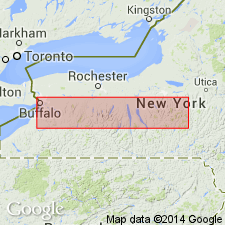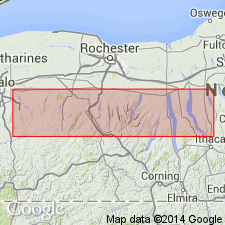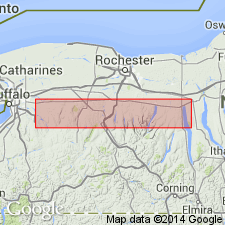
- Usage in publication:
-
- Jaycox Shale Member*
- Modifications:
-
- Named
- Dominant lithology:
-
- Shale
- Limestone
- AAPG geologic province:
-
- Appalachian basin
Summary:
Named as a member of Ludlowville Formation. Named for Jaycox Creek, Geneseo quad, Livingston Co., west-central NY. Consists of light-colored, gray calcareous shale with basal muddy limestone. Thickness is about 3.6 m; ranges from 0.48 to 16 m. Equivalent to upper part of King Ferry Shale Member of Ludlowville Formation east of Seneca Lake. Overlies Wanakah Shale Member of Ludlowville; paraconformably underlies Tichenor Limestone Member of Moscow Formation. Author reassigns Tichenor and overlying Deep Run Shale Member from Ludlowville to Moscow Formation. Unit is fossiliferous. Age is Middle Devonian.
Source: GNU records (USGS DDS-6; Reston GNULEX).

- Usage in publication:
-
- Jaycox Member
- Modifications:
-
- Revised
- Areal extent
- AAPG geologic province:
-
- Appalachian basin
Summary:
Jaycox Member extends from Elma, in Erie Co., eastward to Syracuse and reaches a maximum thickness of 20 to 25 m near Romulus, Seneca Co. The type section of the Jaycox Member as redefined by Mayer (1989) and this report includes 0.77 m of Spafford Member-equivalent mudstone below the Hill's Gulch Bed (basal layer of the Jaycox). This mudstone was originally assigned to the Wanakah Member by Baird (1979). The Jaycox is subdivided at the type section into ascending Hill's Gulch Bed, an unnamed mudstone, TROPIDOLEPTUS-LONGISPINA interval, Green's Landing Coral Bed, Demosponge-MEGASTROPHIA bed, middle Jaycox barren mudstone interval, Cottage City Coral Beds, and upper Jaycox barren siliciclastic mudstone interval. The highest division of the Jaycox, the Benton Run Mudstone, is present only from Hill's Gulch to the central Finger Lakes region. West Jaycox Creek (type locality), Member becomes thinner and richer in bioclasts, while eastward it thickens greatly and all of its lithologic subdivisions become more argillaceous and less fossiliferous. The eastward extension of the Jaycox by Mayer (1990) across the central Finger Lakes region, into the Owasco Lake-Skaneateles Lake region eliminates the need for the name King Ferry Member.
Source: GNU records (USGS DDS-6; Reston GNULEX).

- Usage in publication:
-
- Jaycox Shale Member*
- Modifications:
-
- Overview
- AAPG geologic province:
-
- Appalachian basin
Summary:
Author follows usage of Baird (1979). Jaycox Shale Member shown as upper member of Ludlowville Formation. Overlies Wanakah Shale Member. Age is Middle Devonian.
Source: GNU records (USGS DDS-6; Reston GNULEX).
For more information, please contact Nancy Stamm, Geologic Names Committee Secretary.
Asterisk (*) indicates published by U.S. Geological Survey authors.
"No current usage" (†) implies that a name has been abandoned or has fallen into disuse. Former usage and, if known, replacement name given in parentheses ( ).
Slash (/) indicates name conflicts with nomenclatural guidelines (CSN, 1933; ACSN, 1961, 1970; NACSN, 1983, 2005, 2021). May be explained within brackets ([ ]).

